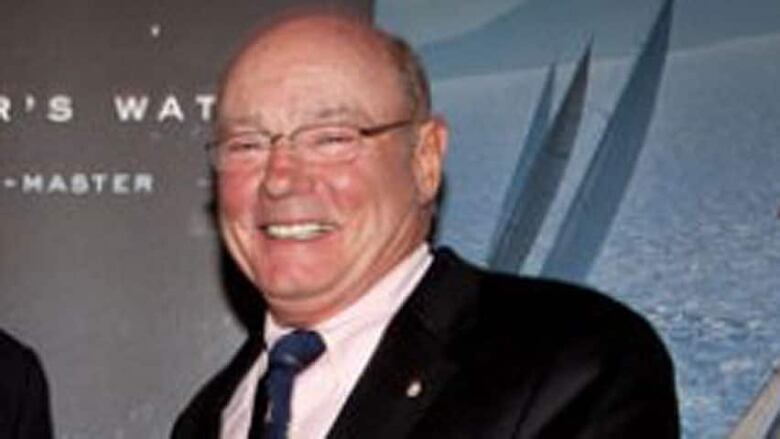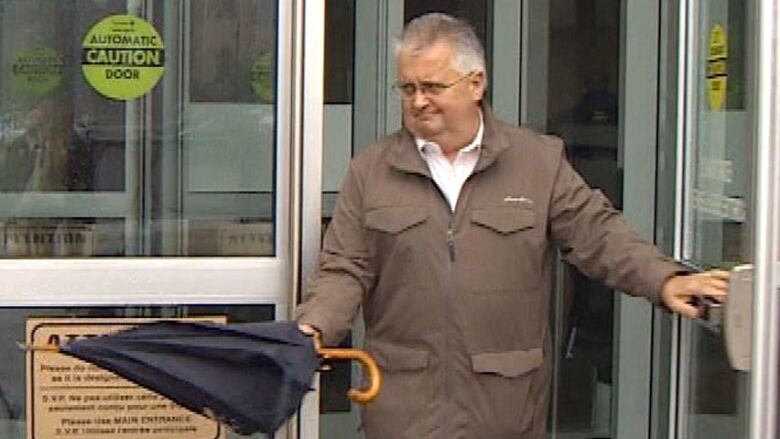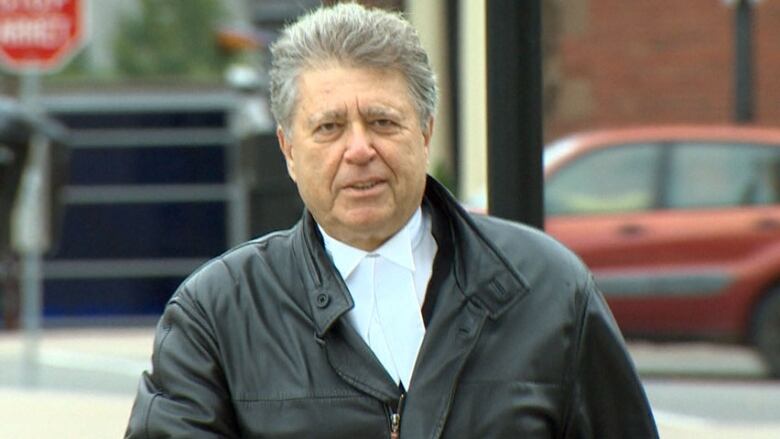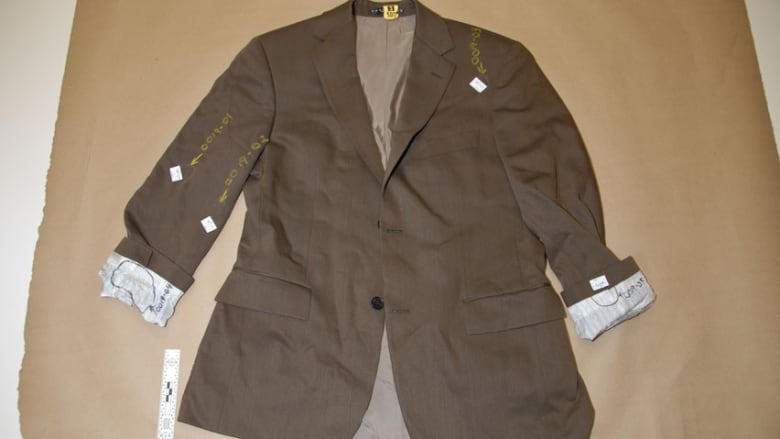Dennis Oland as father's killer an 'inescapable conclusion,' Crown argues
Defence lawyer Alan Gold contends jury no closer to knowing Richard Oland's 'true' killer than 3 months ago

Crown prosecutor P.J. Veniotsays Dennis Olandkilled his father, Richard Oland, and thatis the "only logical, inescapableconclusion" the jury at themurder trial must reach.
Butdefence lawyer Alan Gold contendsthe jurors are no closer to knowing who killed the prominent New Brunswick businessman than they were when they were selected for jury duty three months ago. He saidthat theymust come back with a not guilty verdict.
The lawyers made the statements on Monday while delivering their closing arguments to the jury in the Saint John courtroom. Theypresentedtwo vastly different versions of the evidence, but both urged the jurors to use common sense in deciding the case in their favour.
JudgeJohn Walsh is expected to begin giving his instructions to the jury on Tuesday. He advised the jurorsto bring a bag with them, because they will be sequestered until they can reach a unanimous verdict.

The multimillionaire's body was discovered lying face down in a pool of blood in his Saint John office on July 7, 2011. He had suffered 45 sharp and blunt force injuries to his head, neck and hands. No weapon was ever found.
The accused was the last known person to see his father alive during a meeting at his office the night before.
Timeline key to both Crown, defence
The Crown submits Oland had the opportunity to kill his father sometimebetween 5:44 p.m., when his father's secretaryleft for the day and they werealone together,and 6:36 p.m., when he left and headed home to Rothesay.
Veniot pointed to the last registered human activity on Richard Oland's computer being at 5:39 p.m., right around the time Dennis Oland arrived,and the last message received by Richard Oland'smissing iPhone being a textsent at 6:44 p.m. via a cell tower in Rothesay.

Two witnesses described seeing the accused pick something up near the wharf, walk to the end of the wharf, sit down, put the mystery object he had picked up ina reusable grocery bag, walk briskly back to his car and drive away.
Gold, however, argued that Dennis Olandknew his father'ssecretary's routine, and if he were going to the officeto kill his father, he could have gone later to avoid there being any witnesses.
The defence submits it's more likely Richard Oland was killed around 7:30 p.m. or 7:45 p.m., when Anthony Shaw was working in the Printing Plus office downstairs from Richard Oland's officeand reported hearing "thumping" noises coming from the office.
The jury has seen securityvideo of DennisOlandshopping in Rothesaywith his wife at that time, looking "normal," said Gold.
"It could not be DennisOlandkilling RichardOlandat the time of the noises. It's as simple as that," he said.
Gold also argued it wasn'tunusual for Richard Oland not to use his computer in the evenings, nor was itunusualfor him not to respond to Sedlacek for several hours.
He suggested the victim'siPhonemay have communicated with a cell tower in Rothesaybecause Richard Olandmay have headed that way himself after his son left. That might also explain why alcohol was found in his urine during the autopsy, even though witnesses testified he never left the office that day and didn't keep any alcohol there, said Gold.
'Crime of passion'
Veniot stressed that the iPhone was the only item that went missing from the crime scene. It was not a robbery, he said, noting there were no signs of a break-in and Richard Oland's wallet, Rolex watch, extensive digital equipment and the keys to his BMW were all left untouched.
The "viciousness" of the attack alsoindicates it was a "crime of passion," committed by someone who knew the victim, said Veniot.
He reiterated the Crown's theory that Dennis Oland's financial problems were the possible motive.

He suggested Olandhad asked his father for more money on the night in question. "Why not? Richard Oland had more money than he or [his wife]Connie were ever going to be able to spend in their lifetime. Why not take another bite outof the inheritance?"
But there are "only so many times you couldgo to the Bank of Daddy before beingdeclined," he said.
Gold countered thatmoney troubles were nothing new to Oland.It was normal for his spending to exceed his income and there was no evidence he had tried to get more money from the bank and been refused, he said. There was also no evidence about his father being upset about his financial situation, added Gold.
Police also found "not a shred" of evidence on Dennis Oland's computers of him "planning or carrying out such a terrible crime," he said.
"Never have so many searched so long to find so little," said Gold, adding the lack of evidence against the accused"cries out innocence."
It is not enough to think he is "possibly guilty" or even "probably guilty." He is presumed innocent until the Crown proves guilt beyond a reasonable doubt, he said.
Blood, DNA on brown sports jacket
But Veniotfocused on the discrepancies between what Dennis Oland told police during a voluntary statement on July7, 2011, and his testimony in his own defence.
Oland told police he was wearing a navy blazer when he visited his father on the night in question, but video surveillance and witness testimony showed he was actually wearing a brown jacket that day.
A brown Hugo Boss sportsjacket seized fromOland'sbedroom closet a week after his father's body was found had three small bloodstains on it on the right sleeve, upper left chest and on the back.
The DNA extracted from those stains matched his father's profile. The chances of it not being the victim's DNA were one in 20 quintillion, the trial has heard.
The jacket was taken to the dry cleaners just hours after police told Oland he was a suspect in his father's death, in a bid, Veniot suggested, to destroy any evidence.
Destroying the expensive jacket itself would be "more suspicious," he said. "It's the concept of hiding something in plain sight."

The "true" killer, he said,would have had a "tons" of blood spatter on him or her after the "horrible bloodletting," with blood flying 360 degrees, not "minuscule" "nearly invisible dots."
He showed the jury some of the graphic, bloody crime scene photos, followed by a photo of Oland's jacket that had the "tiny" drops of blood.
Gold said there's noway for anyone to say how the blood got there or how long it had been there,and he suggested the DNAwas the result of "innocent transfer" unrelated to his death.
He also noted there was no blood found in Oland'scar, on hisshoes,pants, BlackBerry or a red resuablegrocery bag he had with him that night.
Gold described the dry cleaning as a"giant red herring. It was Oland's wife, Lisa, who took the jacket and several other clothing items to the dry cleaners to have clean clothes for Richard Oland's visitation and funeral.
Veniotnoted, however, that police found the dry cleaning receipt in a chest of drawers filled with men's clothing.
In addition, Oland told police he went to his father's office twice on the night in question, but mentioned a third visit during his testimony, stressed Veniot.
Gold, however, contends Oland's confusion is an indication ofinnocence, because the"true" killer wouldhave a story ready for police.
He also pointed out thatOlandbelieved he was giving the statement as a witness, not a suspect, and would not have realized how important every detail about his actions would have been.
Gold stressed that Olandchose to testify,subjecting himself to cross-examination by the Crown, when he didn't have to. He was"frank, straightforward and honest," said Gold.












_(720p).jpg)


 OFFICIAL HD MUSIC VIDEO.jpg)
.jpg)



























































































